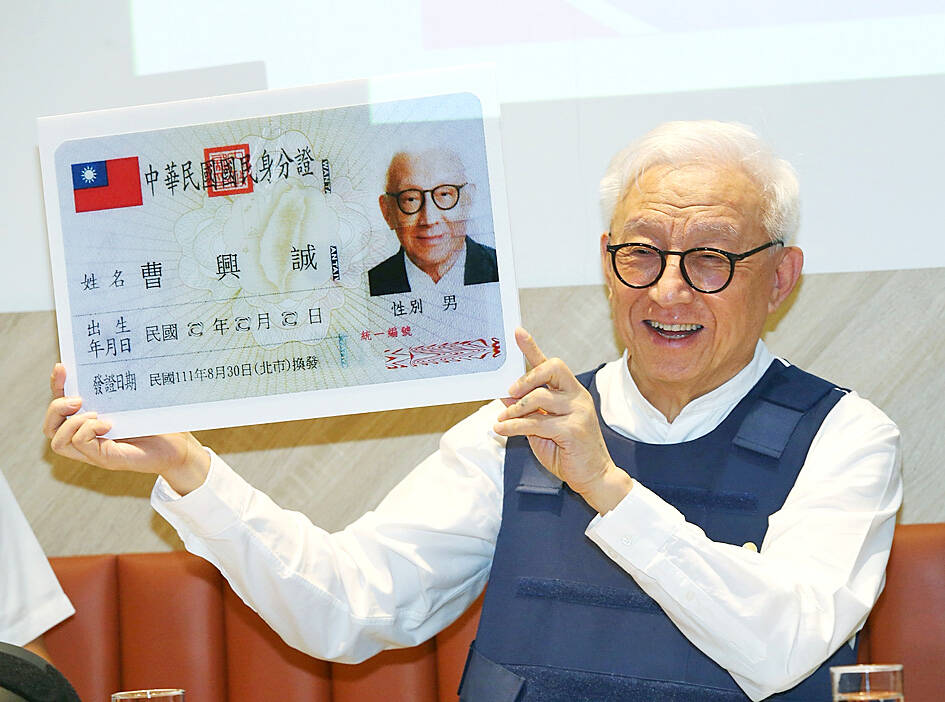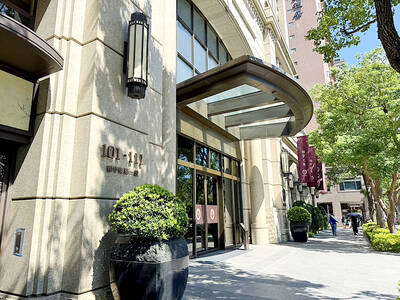A colorful semiconductor tycoon yesterday unveiled plans to train more than 3 million “civilian warriors” to help defend the nation in the event of a Chinese invasion, donating NT$1 billion (US$32.8 million) of his own money.
Robert Tsao (曹興誠), 75, is one of Taiwan’s most successful businessmen and founded major chipmaker United Microelectronics Corp (UMC, 聯電). He has been increasingly outspoken against Beijing, and his pledge came after Chinese troops put on a huge show of force near the nation after US House of Representatives Speaker Nancy Pelosi visited Taipei last month.
For a week after Pelosi’s visit, China sent warships, missiles and fighter jets into the waters and skies around Taiwan, its largest and most aggressive exercises since the mid-1990s.

Photo: CNA
Tsao warned it would be “an intentional slaughter and vicious war crime and crime against humanity” if China were to use force against Taiwan.
The tycoon said he would put NT$600 million toward training 3 million “black bear warriors” in the next three years, adding that they could work alongside the military.
Another NT$400 million would be used to train 300,000 “marksmen” with shooting skills, he said.
Tsao, who no longer holds any position or title at UMC, said the risk posed by China is existential.
“The Chinese Communist Party’s threat to Taiwan is growing and the fight against [it] stands for freedom against slavery, democracy against authoritarianism and civilized against barbaric,” he said.
“If we can successfully resist China’s ambitions, we not only will be able to safeguard our homeland, but make a big contribution to the world situation and the development of civilization,” he added.
Taiwan has spent decades living alongside China’s threats, but the saber-rattling has become more pronounced under Chinese President Xi Jinping (習近平).
China’s most authoritarian leader in a generation, Xi is on the cusp of securing an unprecedented third term later this year and has made gaining Taiwan a key part of his “national rejuvenation” goals.
Taiwan remains massively outgunned, with 88,000 ground forces compared with China’s 1 million troops, the US Department of Defense says.
Mandatory military service for Taiwanese men is just four months, and Taiwanese and US strategists have increasingly pushed Taipei to adopt a “porcupine” strategy of asymmetric warfare, which would include training civilians to fight.
Russia’s stalled invasion of Ukraine has also focused attention in Taiwan on the threats posed by a giant authoritarian neighbor and how huge armies can be resisted by a much smaller, but determined defender.
Tsao yesterday also announced that he had regained Taiwanese citizenship.
Showing an enlarged copy of his Republic of China identification card, Tsao told reporters that he had renounced his Singaporean citizenship, which he obtained in 2011, and was “so excited” to have his original citizenship restored.
From now on, he would stand with his “courageous compatriots” against any invasion by China and ensure that Taiwan remains “the land of the free and the home of the brave,” he said, likening Taiwan to the US.
Additional reporting by CNA

The combined effect of the monsoon, the outer rim of Typhoon Fengshen and a low-pressure system is expected to bring significant rainfall this week to various parts of the nation, the Central Weather Administration (CWA) said. The heaviest rain is expected to occur today and tomorrow, with torrential rain expected in Keelung’s north coast, Yilan and the mountainous regions of Taipei and New Taipei City, the CWA said. Rivers could rise rapidly, and residents should stay away from riverbanks and avoid going to the mountains or engaging in water activities, it said. Scattered showers are expected today in central and

COOPERATION: Taiwan is aligning closely with US strategic objectives on various matters, including China’s rare earths restrictions, the Ministry of Foreign Affairs said Taiwan could deal with China’s tightened export controls on rare earth metals by turning to “urban mining,” a researcher said yesterday. Rare earth metals, which are used in semiconductors and other electronic components, could be recovered from industrial or electronic waste to reduce reliance on imports, National Cheng Kung University Department of Resources Engineering professor Lee Cheng-han (李政翰) said. Despite their name, rare earth elements are not actually rare — their abundance in the Earth’s crust is relatively high, but they are dispersed, making extraction and refining energy-intensive and environmentally damaging, he said, adding that many countries have opted to

FORCED LABOR: A US court listed three Taiwanese and nine firms based in Taiwan in its indictment, with eight of the companies registered at the same address Nine companies registered in Taiwan, as well as three Taiwanese, on Tuesday were named by the US Department of the Treasury’s Office of Foreign Assets Control (OFAC) as Specially Designated Nationals (SDNs) as a result of a US federal court indictment. The indictment unsealed at the federal court in Brooklyn, New York, said that Chen Zhi (陳志), a dual Cambodian-British national, is being indicted for fraud conspiracy, money laundering and overseeing Prince Holding Group’s forced-labor scam camps in Cambodia. At its peak, the company allegedly made US$30 million per day, court documents showed. The US government has seized Chen’s noncustodial wallet, which contains

SUPPLY CHAIN: Taiwan’s advantages in the drone industry include rapid production capacity that is independent of Chinese-made parts, the economic ministry said The Executive Yuan yesterday approved plans to invest NT$44.2 billion (US$1.44 billion) into domestic production of uncrewed aerial vehicles over the next six years, bringing Taiwan’s output value to more than NT$40 billion by 2030 and making the nation Asia’s democratic hub for the drone supply chain. The proposed budget has NT$33.8 billion in new allocations and NT$10.43 billion in existing funds, the Ministry of Economic Affairs said. Under the new development program, the public sector would purchase nearly 100,000 drones, of which 50,898 would be for civil and government use, while 48,750 would be for national defense, it said. The Ministry of